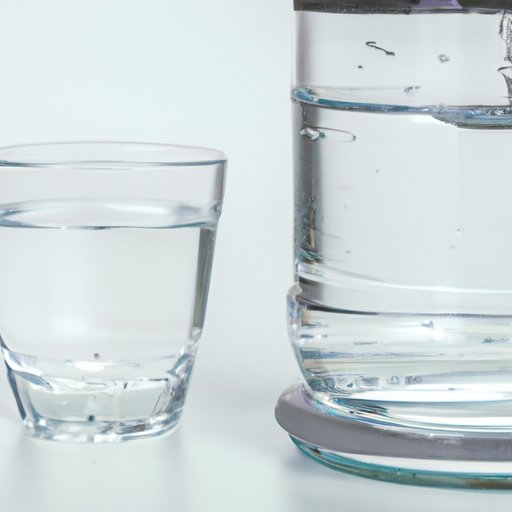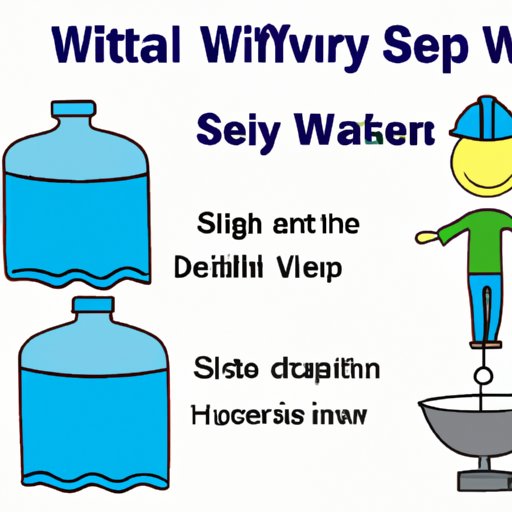
I. Introduction
Have you ever wondered what distilled water is and why it’s important? Distilled water is water that has been purified through a process called distillation, which removes impurities from the water by boiling and then condensing it. It is important because it is free from impurities such as chemicals, minerals, and bacteria, making it safe for consumption and use in various industries. In this article, we will provide you with a step-by-step guide on how to make distilled water at home.
II. Step-by-Step Guide to Making Distilled Water
To make distilled water at home, you will need the following materials:
- A large pot with a lid
- A heat-resistant glass bowl that can fit inside the pot
- A thermometer
- A bowl of ice
- A source of water
Here’s how to make distilled water at home:
- Fill the large pot with water and place the glass bowl inside the pot, making sure that it is not touching the bottom of the pot.
- Place the lid upside down on the pot.
- Turn on the heat and bring the water to a boil.
- Once the water starts boiling, reduce the heat and let it simmer.
- Place the thermometer inside the glass bowl and wait until the temperature reaches 212°F (100°C), which is the boiling point of water.
- As the water boils, steam will rise and hit the cold lid, causing it to condense. The condensed water will drip into the glass bowl.
- Once the temperature inside the glass bowl reaches 200°F (93°C), add a bowl of ice on top of the lid to speed up the condensation process.
- Collect the distilled water in the glass bowl as it drips down.
III. DIY Equipment for Making Distilled Water
Homemade distillation systems can be a more cost-effective option for making distilled water. They can be made using simple materials that can be found around the house. Here are the benefits of homemade distillation systems:
- They are cost-effective
- They are easy to set up and use
- They provide a consistent supply of distilled water
Here’s how to build a homemade distillation system:
- Fill a large pot with water and place a heat-resistant glass bowl in the center of the pot.
- Place a small glass bowl upside down in the center of the heat-resistant bowl.
- Cover the pot with a lid and place a flat rock on top of the lid above the small glass bowl.
- Turn on the heat and bring the water to a simmer.
- The water will boil and produce steam, which will condense on the lid. The condensed water will drip into the small glass bowl.
- Collect the distilled water from the small glass bowl as it drips down.
IV. Boiling Method for Making Distilled Water
Another method for making distilled water at home is the boiling method. This process involves boiling water and then cooling it down to remove impurities. Here’s how it’s done:
- Pour tap water into a heat-resistant glass container and cover it with a lid.
- Place the container on a stove and bring the water to a rolling boil.
- Boil the water for 30 minutes to allow impurities to evaporate.
- Remove the container from the stove and let it cool down.
- Once the water has cooled down, it can be used as distilled water.
Boiled water has several benefits, including:
- It kills most bacteria and viruses
- It is cost-effective
- It is easy to do
V. Solar Distillation for Making Distilled Water
Solar power can also be used to make distilled water. This method uses the sun’s energy to vaporize water and then condense the steam. Here’s how to build a solar still:
- Fill a large container with water and add some rocks to the bottom of the container to weigh it down.
- Place a heat-resistant glass bowl at the center of the container, making sure it doesn’t touch the bottom of the container.
- Cover the container with a clear plastic sheet, leaving a depression in the middle.
- Place a rock in the depression of the plastic sheet to create a slight slope that leads to the heat-resistant glass bowl.
- Place the container in a sunny spot and wait for the sun to heat up the water.
- The heated water will evaporate, condense on the plastic sheet, and drip down into the glass bowl as distilled water.
- Collect the distilled water from the glass bowl as it drips down.
The benefits of using solar power to make distilled water include:
- It is cost-effective in sunny areas
- It uses renewable energy
- It is environmentally friendly

VI. Safety Tips for Making Distilled Water
Like any other DIY project, making distilled water comes with some risks. Here are some safety tips to help you avoid accidents:
- Always use heat-resistant glassware to prevent it from breaking or shattering when exposed to high temperatures.
- Do not touch the glassware when it’s hot to avoid getting burns.
- Always use gloves and goggles when handling hot equipment or boiling water to protect your hands and eyes.
- Ensure proper ventilation to prevent steam from building up and causing burns or respiratory issues.
By following these guidelines, you can make distilled water safely and effectively.
VII. Distilled Water vs. Other Types of Purified Water
Distilled water is not the only type of purified water available. Here’s how it compares to other types of purified water:
- Bottled water is often just purified tap water that has been bottled and sold.
- Filtered water is water that has been passed through a filter to remove impurities.
- Reverse osmosis water is similar to filtered water, but it has been purified through a membrane that removes impurities that are smaller than the water molecules themselves.
While all these types of purified water are safe for consumption, they differ in terms of their composition and how they are made. Distilled water is one of the purest forms of water available, with almost all impurities removed.
VIII. Uses of Distilled Water
Distilled water has many uses in different industries. Here are just a few examples:
- It is used in medical devices such as dialysis machines and IV drips to prevent contamination.
- It is used in the automotive industry to prevent engine damage caused by minerals and other impurities found in tap water.
- It is used in the brewing industry to make beer and other alcoholic beverages.
IX. Conclusion
Distilled water is a pure form of water that is free from impurities and safe for consumption and use in various industries. By following our step-by-step guide, you can make distilled water at home using simple materials. Whether you prefer the DIY method or investing in a water distillation system, you can enjoy the benefits of using distilled water in your home or your industry.
Remember to always follow safety guidelines when making distilled water to avoid accidents or injuries.





